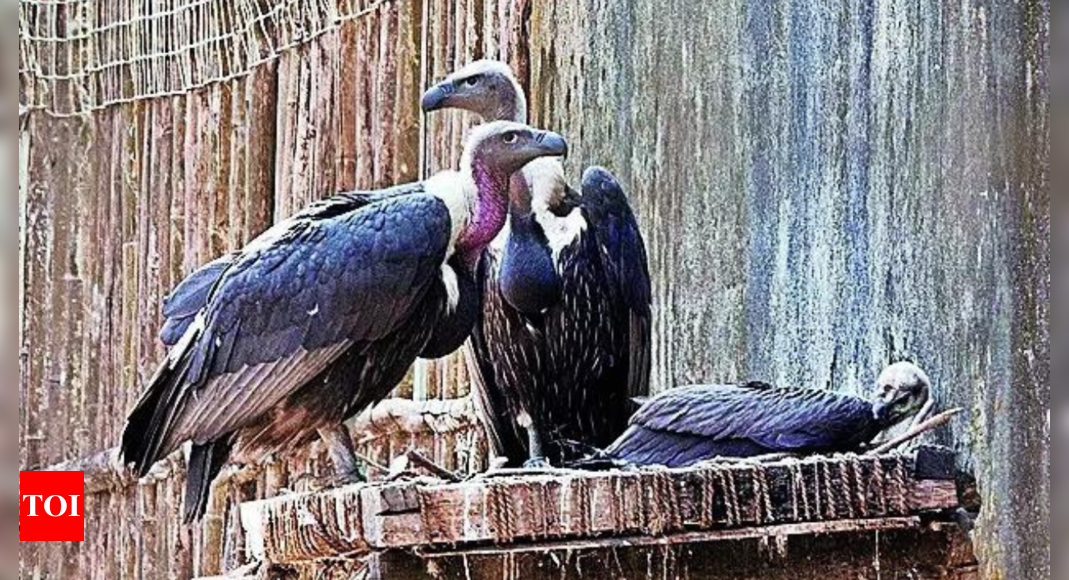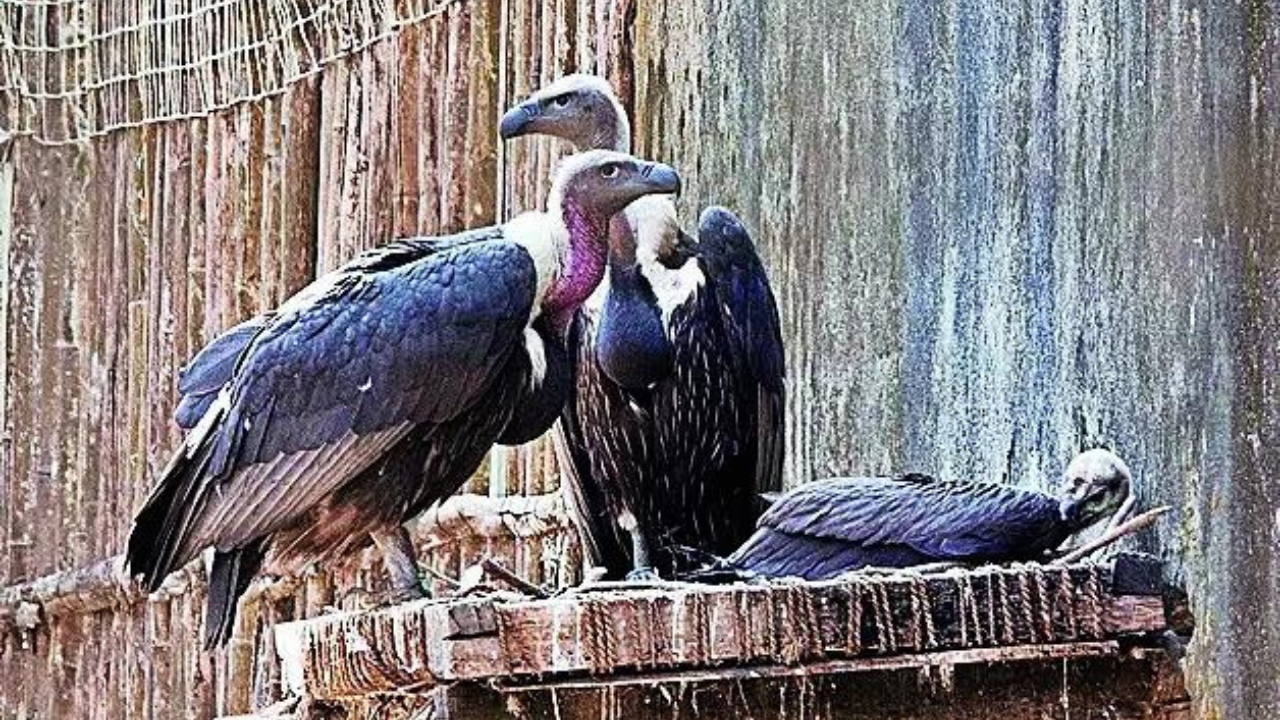[ad_1]
In Jan, when a bronze statue of ‘Jatayu’—the mythical vulture who fought valiantly to save Sita from Ravana—was unveiled at the Ram Temple consecration in Ayodhya, twenty real-life Jatayus or vultures—in desperate need of their own heroic rescue—were soft-released into the lush Tadoba and Pench tiger reserves in Maharashtra. This move was part of a vulture reintroduction program by the Bombay Natural History Society (BNHS) and a significant step forward in helping these unsung heroes — who do the dirty work of cleaning up after death and keeping the environment healthy — make a comeback from the brink of extinction.
Over the next one year, 30 more vultures, out of 750 white-rumped, slender-billed, and long-billed vultures bred at various BNHS centres, will be rewilded in Maharashtra, Madhya Pradesh, and Rajasthan.“BNHS undertook the strategy of reintroducing vultures in tiger habitats with a large prey base to restore vultures in their predestined role as nature’s sanitation crew,” says Praveen Pardeshi, president, BNHS. “We intend to do the same in sanctuaries like Melghat and Koyna in Maharashtra that don’t have vultures as well as in other states.”
Helping vultures reclaim their place in the ecosystem was crucial, according to Pardeshi, and the “next big challenge” following their 2003 discovery of ‘Diclofenac’, a veterinary drug used to treat cattle that was causing mass kidney failure in vultures after they scavenged treated livestock.
This revelation explained the mystery behind the massive crash in vulture population in the ’80s and ’90s that had baffled scientists and prompted the International Union for Conservation of Nature to declare that the Indian vulture was “only one step away from total extinction.” By 2007, 99% of vultures in India—once numbering 40 million— had disappeared, with serious consequences for the environment. Following the findings, the Indian government banned the drug’s veterinary use in 2006.
Despite this, India’s vultures continued to face threats—rapid habitat loss and starvation due to diminished forage. “Almost no farmer leaves their dead cattle outside anymore but buries them because of which no food is available for vultures, as it formerly was, in farmland areas,” notes Pardeshi. He hopes that ample food in Tadoba and Pench National Parks will sustain the vultures, allowing them to recycle the remains of prey hunted by tigers, leopards, and wild dogs and complete vital carbon and nitrogen cycles.
India’s vulture conservation story — that began when BNHS joined forces with the Maharashtra, Madhya Pradesh, Assam, West Bengal, and Haryana forest departments about a decade ago to breed these vital but vulnerable scavengers that often get a bad rap for their ungainly look and scavenging habits— gained international attention at the first ever World Species Congress last month.
Hosted by the International Union for Conservation of Nature and World Association of Zoos and Aquariums, the virtual 24-hour gathering brought together government and environmental agencies to conservationists, wildlife groups and students to chart a “coordinated map of key actions” aimed at species recovery. It’s taken years of work to artificially hatch new fledglings of the three most endangered vulture species every year, research the safety of veterinary drugs, and identify regions in need of protection, “But the fight to revive vulture populations in the wild has not yet been won,” says Kishor Rithe, director of BNHS. “Sensitization of pharmacists and identifying vulture safe zones are some of the challenges before us,” he adds, given pharmacy surveys in 2017–18 that revealed yet again that diclofenac was still easily available.
While BNHS teams are currently out in the field conducting pharmacy surveys, carcass sampling, educating cattle owners and sensitising villagers about vulture nesting colonies, they’re also raising funds to create ‘Vulture Safe Zones’ in UP, MP, and Assam, within a 100 km radius of the release sites, to keep vultures safe beyond the tiger reserves.
“Also, the birds set to take off into the wild will be GPS or satellite tagged to track their movements. With support from the central and state governments, along with international funding agencies, India will definitely be able to revive its Jatayu population to earlier times, and large congregations of vultures will finally soar in the skies freely after nearly two decades,” says an optimistic Rithe.
Over the next one year, 30 more vultures, out of 750 white-rumped, slender-billed, and long-billed vultures bred at various BNHS centres, will be rewilded in Maharashtra, Madhya Pradesh, and Rajasthan.“BNHS undertook the strategy of reintroducing vultures in tiger habitats with a large prey base to restore vultures in their predestined role as nature’s sanitation crew,” says Praveen Pardeshi, president, BNHS. “We intend to do the same in sanctuaries like Melghat and Koyna in Maharashtra that don’t have vultures as well as in other states.”
Helping vultures reclaim their place in the ecosystem was crucial, according to Pardeshi, and the “next big challenge” following their 2003 discovery of ‘Diclofenac’, a veterinary drug used to treat cattle that was causing mass kidney failure in vultures after they scavenged treated livestock.
This revelation explained the mystery behind the massive crash in vulture population in the ’80s and ’90s that had baffled scientists and prompted the International Union for Conservation of Nature to declare that the Indian vulture was “only one step away from total extinction.” By 2007, 99% of vultures in India—once numbering 40 million— had disappeared, with serious consequences for the environment. Following the findings, the Indian government banned the drug’s veterinary use in 2006.
Despite this, India’s vultures continued to face threats—rapid habitat loss and starvation due to diminished forage. “Almost no farmer leaves their dead cattle outside anymore but buries them because of which no food is available for vultures, as it formerly was, in farmland areas,” notes Pardeshi. He hopes that ample food in Tadoba and Pench National Parks will sustain the vultures, allowing them to recycle the remains of prey hunted by tigers, leopards, and wild dogs and complete vital carbon and nitrogen cycles.
India’s vulture conservation story — that began when BNHS joined forces with the Maharashtra, Madhya Pradesh, Assam, West Bengal, and Haryana forest departments about a decade ago to breed these vital but vulnerable scavengers that often get a bad rap for their ungainly look and scavenging habits— gained international attention at the first ever World Species Congress last month.
Hosted by the International Union for Conservation of Nature and World Association of Zoos and Aquariums, the virtual 24-hour gathering brought together government and environmental agencies to conservationists, wildlife groups and students to chart a “coordinated map of key actions” aimed at species recovery. It’s taken years of work to artificially hatch new fledglings of the three most endangered vulture species every year, research the safety of veterinary drugs, and identify regions in need of protection, “But the fight to revive vulture populations in the wild has not yet been won,” says Kishor Rithe, director of BNHS. “Sensitization of pharmacists and identifying vulture safe zones are some of the challenges before us,” he adds, given pharmacy surveys in 2017–18 that revealed yet again that diclofenac was still easily available.
While BNHS teams are currently out in the field conducting pharmacy surveys, carcass sampling, educating cattle owners and sensitising villagers about vulture nesting colonies, they’re also raising funds to create ‘Vulture Safe Zones’ in UP, MP, and Assam, within a 100 km radius of the release sites, to keep vultures safe beyond the tiger reserves.
“Also, the birds set to take off into the wild will be GPS or satellite tagged to track their movements. With support from the central and state governments, along with international funding agencies, India will definitely be able to revive its Jatayu population to earlier times, and large congregations of vultures will finally soar in the skies freely after nearly two decades,” says an optimistic Rithe.
[ad_2]
Source link



